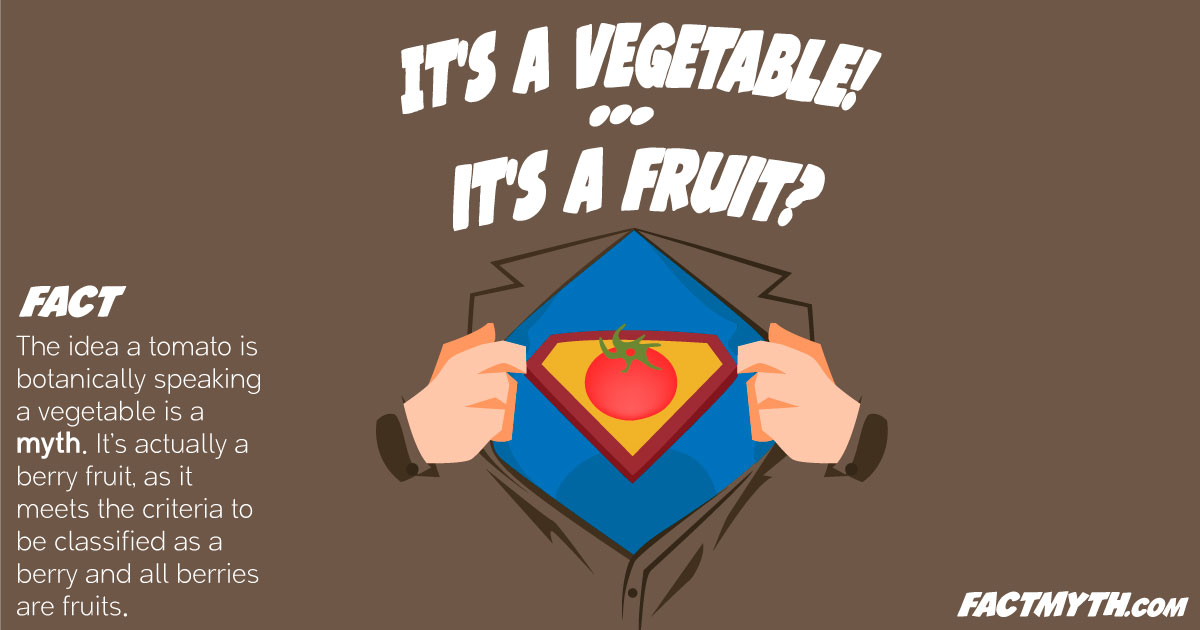It’s not wrong to say a tomato is a vegetable, but botanically speaking tomatoes are berry fruits. Considering in modern day we can make a strong case for calling a tomato a fruit, a berry, and/or a vegetable there is no one correct broad answer as to how to classify a tomato in general terms. Only when talked about in context such as, “botanically speaking”, can we say a tomato is one thing and not the other.
A Tomato is a Fruit fact

A Tomato is a Berry, Fruit, and a Vegetable
A tomato is botanically a berry and therefore a fruit, but it’s treated as a vegetable. It’s accurate to call a tomato a berry, a fruit, and/or a vegetable. It just depends on context.
Summary of why a Tomato is a Fruit (and a Berry and a Vegetable)
- A tomato meets the botanical definition of a berry in that fruit that has seeds enclosed in a fleshy pulp.
- All berries are fruits.
- A tomato does not meet the botanical definition of a vegetable. It is a part of a plant that is edible, but that part need not have a role in the plant’s reproductive cycle. For example, it need not contain seeds. Despite this, a tomato is used as a vegetable in the culinary world and was even determined to be a vegetable by the United States Supreme Court for tax purposes.
Botanically, a Tomato is Not a Vegetable… It’s a Berry Fruit.
The idea a tomato is unequivocally a vegetable is a myth; it’s actually a berry fruit as it meets the criteria to be classified as a berry and all berries are fruits. Despite this, there are many arguments for considering a tomato a vegetable since this is how it is treated and used in every day life.
A video about a tomato being a fruit.What Makes a Fruit a Fruit, a Berry a Berry, and a Vegetable a Vegetable?
The words fruit, vegetable, and berry have a more precise definition in botany than they do in general use. [1]
- To a botanist, a fruit is an entity that develops from the fertilized ovary of a flower. This means that tomatoes, squash, pumpkins, cucumbers, peppers, eggplants, corn kernels, and bean and pea pods are all fruits; so are apples, pears, peaches, apricots, melons and mangos. [2]
- A vegetable, botanically, is any edible part of a plant that doesn’t happen to be a fruit, as in leaves (spinach, lettuce, cabbage), roots (carrots, beets, turnips), stems (asparagus), tubers (potatoes), bulbs (onions), and flowers (cauliflower and broccoli).[2]
- To make things a little bit more confusing, some berry fruits like bananas and tomatoes are technically berries as well as fruits (all berries are fruits). In everyday language, a berry is a small, pulpy and often edible fruit.[3]
The Modern Tomato: Tomatoes V. the Supreme Court
Science aside, tomatoes are commonly treated by vegetables in the culinary world and are actually classified as vegetables by the United States Supreme Court in Robertson v. Salomon due to confusion over how they should be taxed by the Tariff Act of 1883, which levied an import duty on “foreign vegetables” . [2]
- “Plant“. Wikipedia.org. Retrieved Sept 28, 2015.
- “Is a Tomato a Fruit? It Depends on How You Slice It”. Nationalgeographic.com. Retrieved Sept 28, 2015.
- “Berry“. Wikipedia.org. Retrieved Sept 28, 2015.
